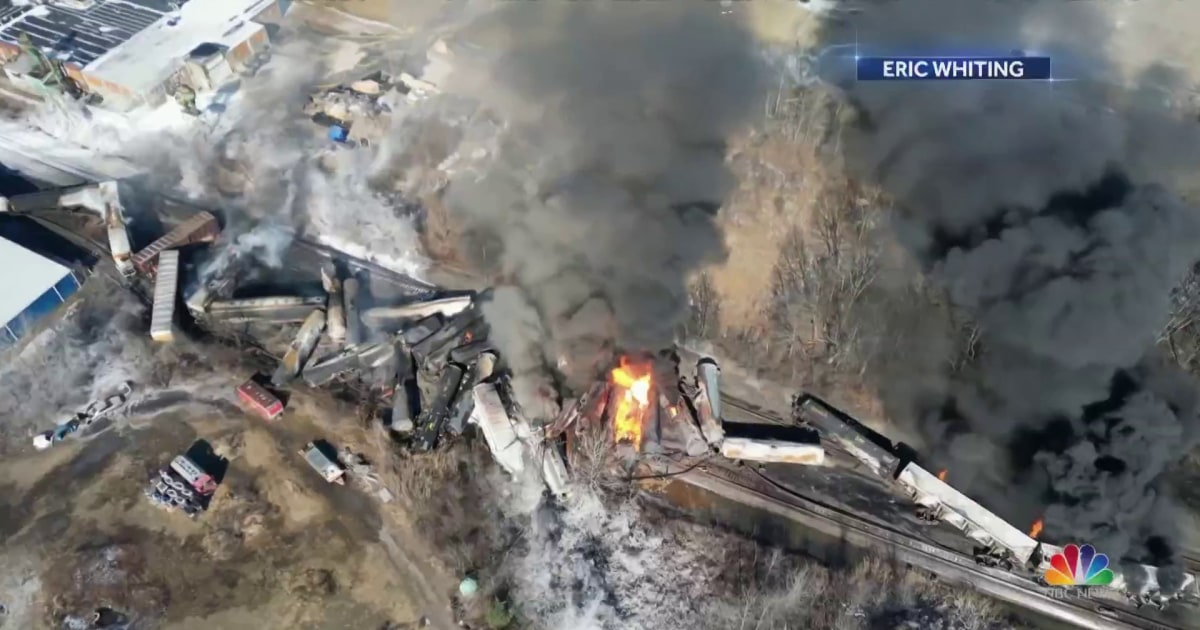Ohio Train Derailment: Toxic Chemical Residue In Buildings After Months

Table of Contents
Types of Chemicals and Their Persistence
The derailment involved a multitude of hazardous materials, but some of the most concerning include vinyl chloride, butyl acrylate, and ethylene glycol monobutyl ether. These chemicals possess properties that contribute to their persistence in the environment and within building structures. Their ability to adhere to various surfaces, coupled with slow degradation rates, means they are not easily removed.
- Adhesion to surfaces: These chemicals can bind tightly to materials like wood, drywall, carpeting, and even paint, making thorough decontamination extremely challenging.
- Slow degradation rates: Many of the released chemicals break down slowly, meaning they can remain in the environment and buildings for extended periods, posing a prolonged threat.
- Potential for vaporization and recontamination: Some chemicals can vaporize and then recontaminate surfaces after initial cleanup attempts, creating a cyclical problem.
The challenges in detecting and removing these chemicals are substantial, necessitating advanced environmental remediation techniques and sophisticated analytical methods to ensure effective chemical persistence mitigation.
Testing Methods and Findings
Testing for chemical residue in buildings following the Ohio train derailment involves several methods, each with its limitations:
- Air quality testing: Measures airborne concentrations of volatile organic compounds (VOCs) to assess indoor air quality and potential inhalation risks.
- Surface sampling: Involves collecting samples from various surfaces (walls, floors, furniture) to analyze the presence and concentration of chemicals.
- Water testing: Examines water sources for contamination, ensuring the safety of drinking water and preventing potential exposure through indirect routes.
The complexity of the chemical mixtures released during the derailment poses a significant challenge to accurate and comprehensive testing. Access to all affected buildings also presents logistical hurdles. While some testing data has been released, showing varying levels of contamination levels in different locations, there are ongoing debates about the comprehensiveness and accuracy of the testing methodologies. Discrepancies in reported findings underscore the need for more rigorous and transparent data collection.
Health Concerns and Long-Term Effects
Exposure to the chemicals released during the Ohio train derailment poses significant short-term and long-term health risks. The potential health consequences are substantial and far-reaching:
- Respiratory problems: Inhalation of these chemicals can lead to immediate respiratory irritation and, in severe cases, long-term lung damage.
- Skin irritation: Direct skin contact can cause rashes, burns, and other dermatological issues.
- Cancer risks: Several of the chemicals involved are classified as carcinogens, increasing the risk of various cancers over time.
- Reproductive health concerns: Exposure to these chemicals can negatively impact reproductive health, potentially leading to fertility issues and birth defects.
The uncertainty surrounding the long-term effects of prolonged exposure to low levels of these chemicals is a major concern. Further research is critical to fully understand the potential long-term health effects of this toxic exposure.
Government Response and Community Concerns
The government's response to the Ohio train derailment has been criticized for its speed and adequacy. While cleanup efforts have been undertaken, including soil remediation and water treatment, residents of East Palestine remain deeply concerned about the ongoing health risks and the long-term impact on their community.
- Cleanup efforts: While significant efforts have been made, questions remain regarding the thoroughness of the cleanup and the potential for lingering contamination.
- Community concerns: Residents express frustration over communication gaps, perceived lack of transparency, and ongoing anxieties about their health and the future of their community.
- Legal action: Lawsuits have been filed against the railroad company and other responsible parties, highlighting the significant legal and ethical implications of the disaster.
These community concerns underscore the need for a more robust and transparent government response, including comprehensive long-term monitoring, accessible healthcare resources, and continued support for affected residents.
Conclusion: Addressing the Lingering Threat of the Ohio Train Derailment
The Ohio train derailment aftermath continues to unfold, with the presence of persistent toxic chemical residue in buildings months after the initial event. The associated health risks, coupled with ongoing community concerns, demand a sustained and comprehensive response. Continued monitoring, thorough and independent testing, and transparent communication from authorities are paramount. Addressing the toxic chemical cleanup and protecting public health requires long-term solutions and accountability from responsible parties. We must ensure adequate resources are dedicated to addressing the public health concerns and aiding the East Palestine recovery. Stay informed, support the affected communities, and demand accountability to prevent future tragedies and ensure justice for those impacted by this devastating event.

Featured Posts
-
 Jacob Alon A Dentists Unexpected Career Change And Lessons Learned
May 31, 2025
Jacob Alon A Dentists Unexpected Career Change And Lessons Learned
May 31, 2025 -
 Kham Pha Gia The Va Su Nghiep Pickleball Cua Sophia Huynh Tran
May 31, 2025
Kham Pha Gia The Va Su Nghiep Pickleball Cua Sophia Huynh Tran
May 31, 2025 -
 Find Your New Home Two Week Free Accommodation Offer In A German City
May 31, 2025
Find Your New Home Two Week Free Accommodation Offer In A German City
May 31, 2025 -
 Rare Banksy Collection Six Screenprints Plus A Hand Crafted Tool
May 31, 2025
Rare Banksy Collection Six Screenprints Plus A Hand Crafted Tool
May 31, 2025 -
 Molly Jongs How To Lose Your Mother A Summary For Busy Readers
May 31, 2025
Molly Jongs How To Lose Your Mother A Summary For Busy Readers
May 31, 2025
